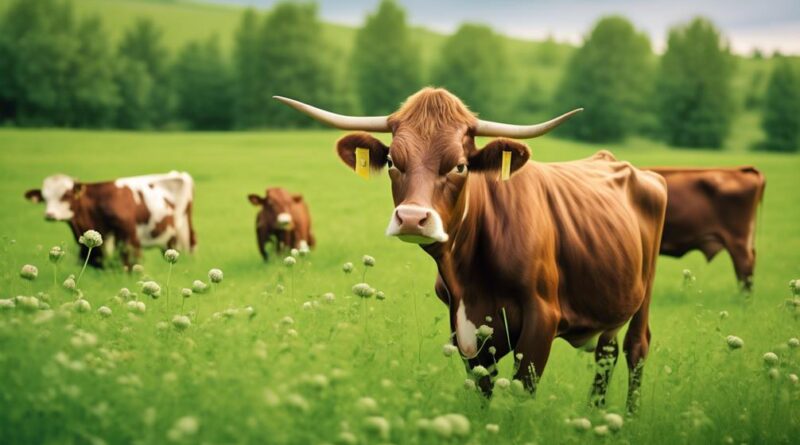Top Forage Mixtures for Successful Cattle Grazing
When it comes to successful cattle grazing, the key is to find forage mixtures that not only provide ample nutrition but also support overall herd health.
But how do you know which mixtures will be the most beneficial for your cattle?
Understanding the benefits of diverse forage mixtures, identifying the key components for optimal grazing, and considering seasonal variations are all essential factors to consider.
By implementing these strategies, you can ensure that your cattle are getting the best possible nutrition from their grazing experience.
So, what are the top forage mixtures that can make a real difference for your cattle?
Benefits of Diverse Forage Mixtures
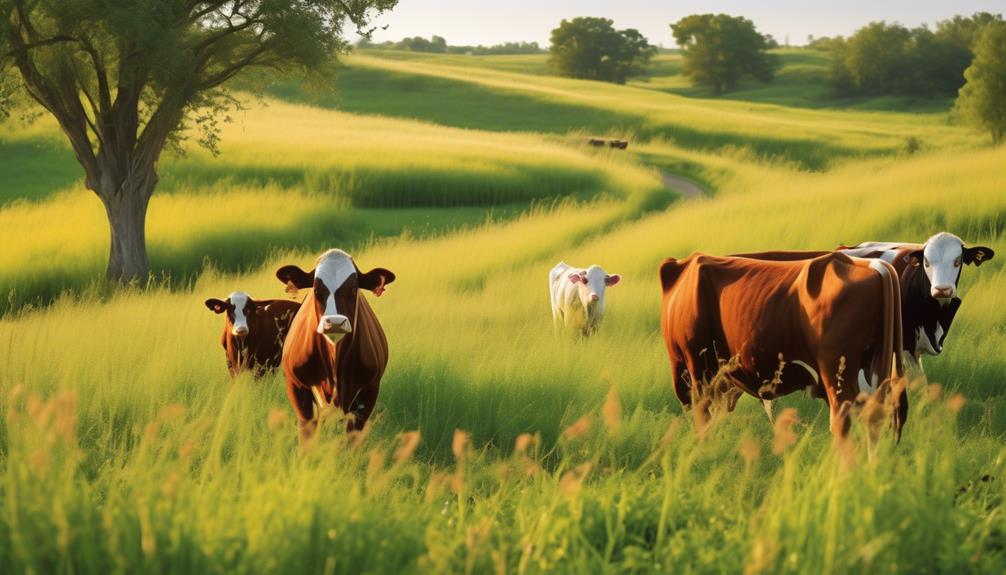
When grazing cattle, utilizing diverse forage mixtures not only enhances their nutrition but also promotes healthier pastures. Grazing efficiency is improved through the inclusion of a variety of forage species in the pasture. Different forage species have different growth patterns and nutritional content, allowing cattle to find a wider array of nutrients within the same area. This reduces the need for cattle to travel long distances within the pasture to find suitable forage, thereby maximizing their grazing efficiency.
Species diversity in forage mixtures also contributes to healthier pastures. Diverse forage mixtures help prevent overgrazing of specific plant species, as cattle will naturally prefer certain forages over others. By having a variety of forage species available, the grazing pressure is more evenly distributed, preventing the depletion of any one plant species. This ultimately leads to improved pasture resilience and sustainability.
Moreover, the nutritional benefits of forage variety can't be overstated. Different forage species offer varying levels of protein, energy, and essential nutrients. By providing a diverse array of forage options, cattle have the opportunity to self-select a diet that meets their individual nutritional needs. This can lead to improved cattle health and productivity, as well as potentially reducing the need for costly supplemental feed.
Key Components for Cattle Grazing
To maximize cattle grazing efficiency, carefully selecting and managing forage mixtures is essential. Cattle nutrition is a critical aspect of pasture management, and the key components for successful cattle grazing involve a combination of high-quality forage species, proper grazing management, and pasture rotation.
When it comes to cattle nutrition, it's important to ensure that the forage mixtures provide the necessary nutrients for the cattle's growth, reproduction, and overall health. This involves understanding the nutritional needs of the cattle and selecting forage mixtures that meet those requirements.
In addition to the nutritional aspect, pasture management plays a crucial role in maximizing cattle grazing. Proper pasture management involves monitoring the forage growth, implementing grazing rotation to prevent overgrazing, and ensuring that the pastures have adequate rest periods to allow forage regrowth. By carefully managing the forage mixtures and grazing patterns, you can optimize the utilization of the available forage, leading to improved cattle performance and overall pasture health.
Furthermore, the diversity of forage mixtures is a key component for successful cattle grazing. By incorporating a variety of forage species with different growth patterns and nutritional profiles, you can create a more resilient and productive grazing system. This diversity not only provides a wider range of nutrients for the cattle but also helps to improve the overall resilience of the pasture ecosystem.
Seasonal Forage Mixtures for Grazing
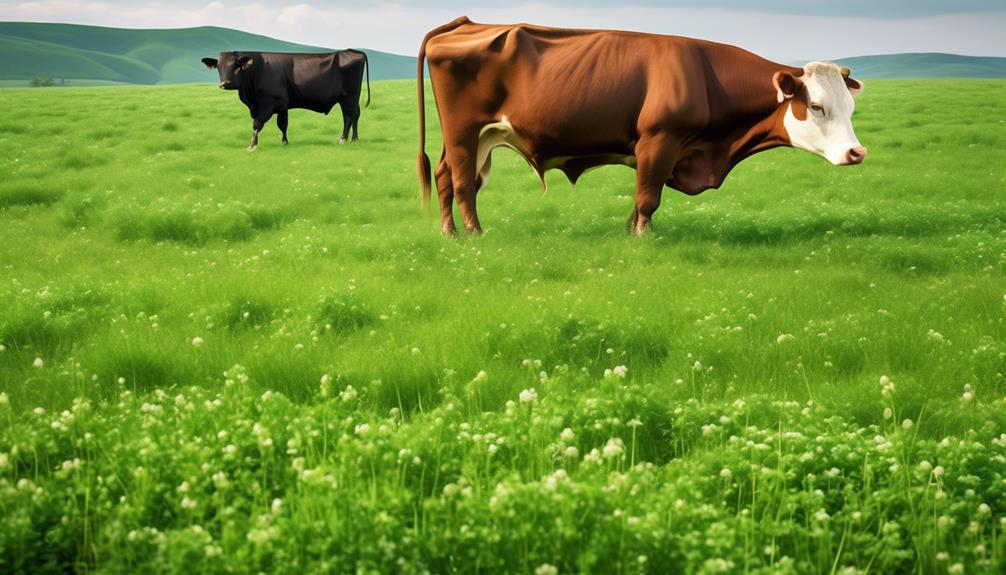
Consider incorporating a diverse range of forage species in your grazing system to optimize cattle nutrition throughout the changing seasons. Grazing management and pasture rotation are crucial for maintaining healthy forage stands. Implementing seasonal forage mixtures can help ensure a continuous supply of high-quality forage, supporting both forage nutrition and animal health.
In the spring, include cool-season grasses like ryegrass, fescue, and orchardgrass in your forage mixtures. These grasses provide abundant, nutritious forage as they thrive in the cooler temperatures of the season. Legumes such as clover and alfalfa can also be valuable additions, enhancing forage quality with their high protein content.
As temperatures rise, transitioning into the summer season, warm-season grasses like Bermuda grass, switchgrass, and big bluestem become more suitable for grazing. These grasses offer excellent drought tolerance and can withstand hot, dry conditions, providing reliable forage during the summer months.
In the fall, consider integrating brassicas such as turnips, kale, and radishes into your forage mixtures. These fast-growing, high-yielding plants can supplement the dwindling warm-season grasses, ensuring a consistent forage supply as temperatures cool.
Considerations for Soil Health and Forage
Improving soil health is essential for optimizing forage growth and cattle grazing. When considering soil health, it's crucial to focus on improving fertility, enhancing soil structure, and promoting nutrient cycling.
Healthy soil fertility ensures that forage plants have the necessary nutrients for robust growth. You can enhance soil fertility by incorporating organic matter, such as compost or manure, and using fertilizers tailored to your specific soil needs.
Additionally, maintaining proper soil structure is vital for optimal forage growth. Compacted soil can hinder root development and water infiltration, so practices like rotational grazing and minimizing soil disturbance can help improve soil structure.
Nutrient cycling is another key aspect to consider. It involves the natural processes through which nutrients are recycled and made available to plants. To support nutrient cycling, implementing diverse forage mixtures can be beneficial as different plants have varying nutrient requirements and contribute to a more balanced nutrient cycle. Forage selection also plays a critical role in maintaining soil health. When choosing forage species, consider their impact on soil health, such as their root structure and nutrient uptake abilities.
Moreover, effective grazing management is essential for preserving soil health. Proper grazing techniques, like rotational grazing and maintaining appropriate stocking rates, can prevent overgrazing and soil compaction, promoting healthier soil and forage growth.
Implementing Legumes in Forage Mixtures
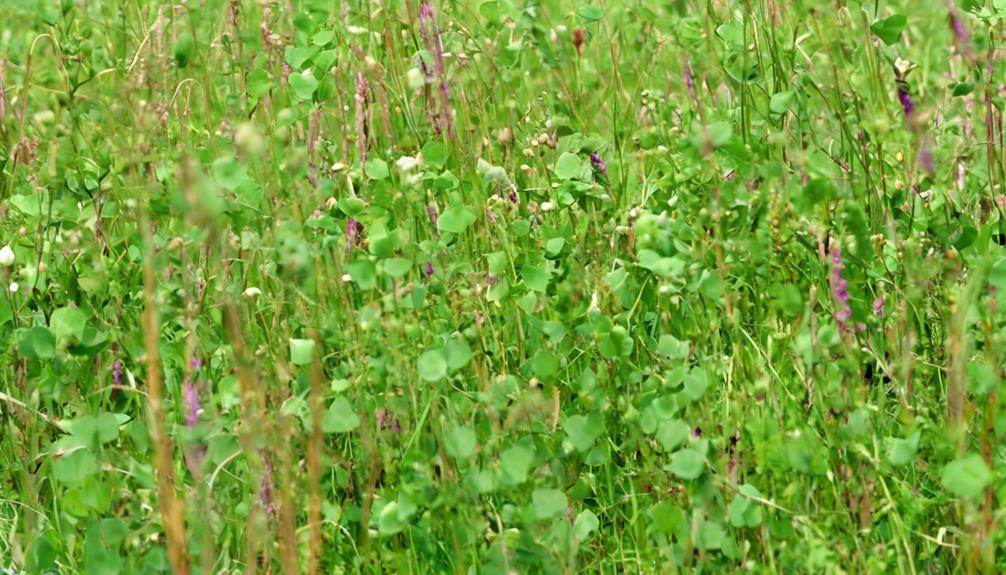
Incorporating legumes into your forage mixtures can significantly enhance the nutritional value and sustainability of cattle grazing. By introducing legumes, you can maximize productivity and improve the overall nutritional balance of the forage available to your cattle.
- Nitrogen Fixation: Legumes have the unique ability to fix nitrogen from the atmosphere into a form that's readily available to plants. This can reduce the need for synthetic fertilizers and enhance the nitrogen content of the forage, promoting healthier and more robust grazing.
- Improved Forage Quality: Legumes, such as clover and alfalfa, are rich in protein and other essential nutrients. When included in forage mixtures, they elevate the overall nutritional value, providing a well-balanced diet for your cattle and supporting their growth and development.
- Enhanced Soil Health: The presence of legumes can improve soil structure and fertility. Their deep root systems help to break up compacted soil, increase water infiltration, and promote beneficial microbial activity, contributing to a healthier grazing environment.
- Sustainability: Incorporating legumes into your forage mixtures supports sustainable agricultural practices. Their nitrogen-fixing ability reduces the environmental impact of synthetic fertilizers, while also contributing to the long-term health and productivity of your grazing land.
Integrating legumes into your forage mixtures is a proactive step towards ensuring the well-being of your cattle, while also promoting the overall sustainability and productivity of your grazing operation.
Forage Mixture Management Techniques
To effectively manage forage mixtures for cattle grazing, it's essential to employ strategic techniques that optimize the nutritional value and sustainability of the available forage.
Grazing rotation is a key management technique that involves moving cattle between different paddocks or pastures on a scheduled basis. This helps in preventing overgrazing in specific areas, allowing forage to recover and ensuring a more even distribution of grazing pressure. By implementing grazing rotation, you can effectively manage forage mixtures by promoting even regrowth and preventing depletion of specific forage species.
Another crucial technique for forage mixture management is considering soil fertility. Regular soil testing helps in determining the nutrient levels in the soil and allows for the application of appropriate fertilizers to maintain optimal forage growth. Proper soil fertility management ensures that the forage mixture maintains its nutritional value, supporting the health and productivity of grazing cattle.
Grazing intensity is also a significant factor in forage mixture management. Adjusting the stocking rate based on forage growth and availability helps in preventing overgrazing and ensures that the forage mixture can sustain the nutritional needs of the grazing cattle. Monitoring forage growth and adjusting the grazing intensity accordingly is essential for maintaining a healthy and productive forage mixture.
Evaluating Forage Quality for Grazing
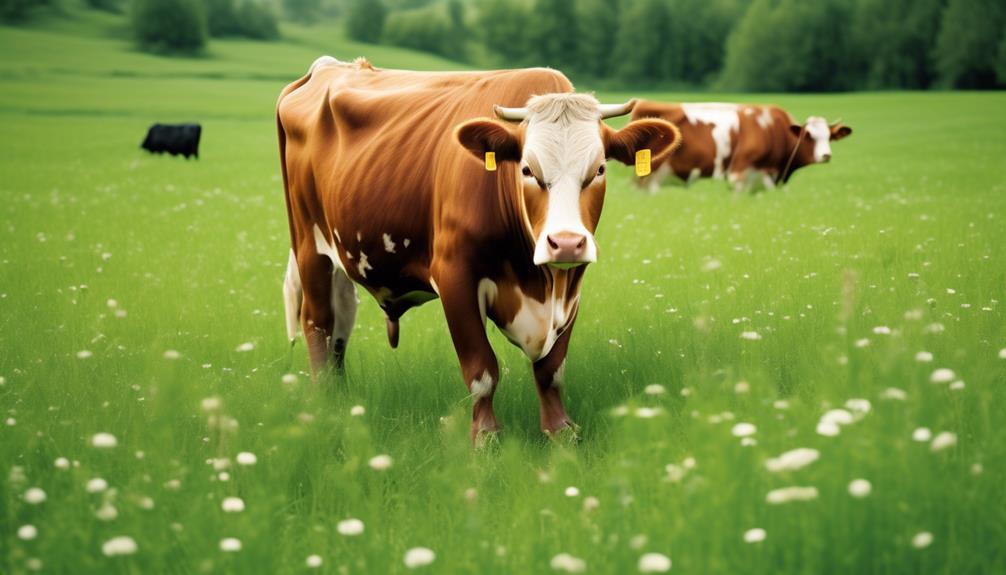
Assessing forage quality for grazing is essential for ensuring optimal nutrition and health for your cattle. Evaluating nutritional content and understanding your cattle's grazing behavior and preferences are crucial for making informed decisions about forage quality.
Here are some key factors to consider when evaluating forage quality for grazing:
- Nutritional Content: Analyze the nutritional composition of the forage, including protein, fiber, energy, and mineral content. Understanding the nutritional value of the forage will help you provide a balanced diet for your cattle and ensure they receive the necessary nutrients for growth and maintenance.
- Grazing Behavior: Observe your cattle's grazing behavior to determine their preferences for different forage types. Understanding which forages they prefer can help you optimize grazing patterns and ensure they've access to their preferred forage species.
- Palatability: Assess the palatability of the forage to ensure that your cattle will readily consume it. Factors such as taste, texture, and aroma can influence palatability, so it's important to consider these aspects when evaluating forage quality.
- Digestibility: Evaluate the digestibility of the forage to determine how efficiently your cattle can extract nutrients from it. High digestibility can lead to improved feed efficiency and overall animal performance.
Maximizing Forage Diversity for Cattle
Maximize the nutritional benefits and grazing potential for your cattle by diversifying forage options in their grazing areas. Improving pasture by increasing forage diversity is crucial for optimizing cattle grazing. By introducing a variety of forage species, you can provide a more balanced and complete diet for your cattle.
Different forage species have varying nutritional profiles, so a diverse range can help ensure that your cattle are getting all the essential nutrients they need.
Incorporating a mix of grasses, legumes, and forbs into your pasture can improve its overall quality. Different forage species have different root structures, which can help improve soil health and prevent erosion. Moreover, diverse forage options can increase the palatability of the grazing area, encouraging cattle to utilize more of the pasture.
Grazing optimization can also be achieved by implementing rotational grazing systems that take advantage of the diverse forage options available. Rotational grazing allows forage to recover and regrow, promoting sustainable land use and ensuring a continuous supply of high-quality forage for your cattle.
Frequently Asked Questions
What Are the Potential Drawbacks or Challenges of Using Diverse Forage Mixtures for Cattle Grazing?
When using diverse forage mixtures for cattle grazing, potential drawbacks and management challenges may arise. It's important to carefully monitor the impact on cattle health and ensure proper management of rotational grazing for optimal results.
How Can Forage Mixtures Be Tailored to Meet the Specific Nutritional Needs of Different Types of Cattle?
To tailor nutrition for different cattle types, consider their specific needs. This boosts productivity and ensures the forage mixtures address soil fertility and drought resistance. Employ monitoring techniques to optimize grazing and make necessary adjustments.
Are There Any Specific Forage Mixtures That Are Particularly Well-Suited for Grazing in Drought-Prone Areas?
In drought-prone areas, specific forage mixtures can offer potential benefits for successful cattle grazing. Opt for mixtures with deep-rooted plants, like alfalfa and clover, to support grazing strategies and provide resilience during dry spells.
What Are Some Potential Long-Term Effects of Using Forage Mixtures on Soil Health and Fertility?
Using forage mixtures can have long-term effects on soil health and fertility. It can improve soil structure, increase organic matter, and enhance nutrient cycling. You should consider the nutritional needs of cattle and grazing conditions.
How Can Farmers Effectively Monitor and Adjust Forage Mixtures to Ensure Optimal Grazing Conditions for Their Cattle Throughout the Year?
To effectively monitor and adjust forage mixtures for optimal grazing conditions, employ rotational grazing, assess nutritional balance, and adapt to climate changes. Implement monitoring techniques like assessing pasture health and utilizing soil tests for successful cattle grazing.
Conclusion
In conclusion, diverse forage mixtures are essential for successful cattle grazing.
By incorporating key components, seasonal varieties, and legumes, you can improve soil health and maximize forage diversity.
Implementing proper management techniques and regularly evaluating forage quality will ensure that your cattle have access to the best grazing options.
With the right forage mixtures, you can support the health and productivity of your cattle while maintaining a sustainable grazing system.
